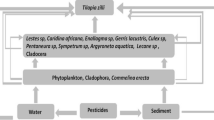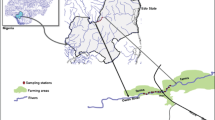Abstract
A study was conducted in the southeastern region of Buenos Aires province, Argentina, to assess an agricultural soil as a potential source of organochlorine (OC) pesticides for the aquatic biota of a nearby pond. We analyzed γ-HCH (lindane), still in use, and the following banned compounds: DDT, DDE, DDD heptachlor, heptachlor epoxide, aldrin, dieldrin and endrin in soil, bulrush, grass shrimp and fish using gas chromatography with electron capture detection (GC-ECD). Among the OC pesticides, lindane was most dominant in the soil (32.6 ng/g dry wt in the upper and 173.9 ng/g dry wt in the lower horizon) and bulrush (1.9 μg/g lipid). Macrophyte also accumulated high levels of heptachlor epoxide (1.5 μg/g lipid). Heptachlor, although present in the soil, was below the detection limit in all aquatic biota studied. Its primary degradation product, heptachlor epoxide, was found in both soil and biota samples. DDT was found at low levels in the surface soil (6.8 ng/g dry wt), but at higher concentrations in fish (3.6 μg/g lipid), although levels were still below permissible levels for human consumption. Since most of the compounds were found in both soil and aquatic biota, our study suggests that agricultural soil could be an important source for OC pesticides in the nearby pond.
Similar content being viewed by others

References
Aigner EJ, Leone AD, Falconer RL (1998): Concentrations and enantiomeric ratios of organochlorine pesticides in soils from the US Corn Belt. Environmental Science and Technology32, 1162–1168
Antonius GF, Byers ME (1997): Fate and movement of endosulphane under field conditions. Environmental Toxicology and Chemistry16, 644–649
Banerjee P, Piwoni MD, Ebeid K (1985): Sorption of organic compounds to a low carbon subsurface core. Chemosphere14, 1057–1067
Bidleman TF, Widequist V, Jansson B, Soderlund R (1987): Organochlorine pesticides and polichlorinated byphenyls in the atmosphere of southern Sweden. Atmospheric Environment21, 641–654
Bidleman TF, Patton GW, Walla MD, Hargrave BT, Vass WP, Erickson P, Fowler B, Scott V, Gregor DJ (1989): Toxaphene and other organochlorines in Arctic ocean fauna: evidence for atmospheric delivery. Arctic42, 307–313
Biernacki M, Lovett-Doust J, Lovett-Doust L (1995a): The effects of trichloroethylene, plant sex and site of origin on modular demography inVallisneria americana. Journal of Applied Ecology 32, 761–777
Biernacki M, Lovett-Doust J, Lovett-Doust L (1995b): Sediment effects on the uptake of trichloroethylene by roots and leaves inVallisneria americana. In the Lake Huron Ecosystem: Ecology, Fisheries and Management. Ecovision World Monograph Series, S.P.B. Academic Publishing. The Netherlands
Bocanegra EM, Martinez DE, Massone HE, Cionchi JL (1993): Exploitation effects and salt water intrusion in the Mar del Plata aquifer Argentina. In: Custodio E, Galofré A (Eds): Study and Modeling of saltwater. Intrusion into aquifer. Proceeding of the saltwater intrusion meeting 1–6 November 1992. Barcelona, Spain. CIMNE Ed. 177–191
Canadian Water Quality Guidelines (1987): Canadian Council of Resource and Environmental Ministers. 6-142/VII-11
Charizopoulos E, Papadopoulou-Mourkidou E (1999): Occurrence of pesticides in rain of the Axios River Basin, Greece. Environmental Science and Technology 33, 2363–2368
Cheng HH (1990): Pesticides in the soil environment: Processes, impacts and modeling. Soil Society of America, Book Series 2, Madison, Wisconsin, USA
Dadon JR, Vicari RL (1995): Biomasa de vegetation palustre (Schoenoplectus californicus). In: Ecosistemas de aguas continentales. Metodología para su estudio. I. Lopretto EC and Tell G, Sur Ed 177–182
Del Río JL, Massone HE, Bó J, Martínez Arca J, Bernasconi V, Bocanegra EM, Osterrieth ML, Farenga M, Ferraro R, López de Armentía A, Tomas M (1993): Planification territorial sobre criterios geoambientales en la Cuenca del arroyo y laguna de Los Padres. XII Congreso Geológico Argentino y II Congreso de Exploration de Hidrocarburos. Actas T° VI 293–302
Dimond JB, Owen RB (1996): Long-term residue of DDT compounds in forest soils in Maine. Environmental Pollution92, 227–230
Donnald DB, Block H, Wood J (1997): Role of groundwater hexachlorocyclohexane (lindane) detection in surface water in western Canada. Environmental Toxicology and Chemistry16, 1867–1872
Edwards CA (1966): Insecticide residues in soils. Residue Reviews13, 82–132
Galehouse JS (1971): Sedimentation analysis. In: RE Carver (Eds): Procedures in sedimentary petrology. Edited by University of Georgia, Georgia, USA. Chapter 4
Gao JP, Maguhn J, Spitzauer P, Kettrup A (1998): Sorption of pesticides in the sediment of the Teufelsweiher pond (southeastern Germany). I: Equilibrium assessments, effects of organic carbon content and pH. Water Research32, 1662–1672
González Sagrario MA, Aizpün de Moreno JE, Moreno VJ, Escalante AH (1998): Dynamics of organochlorine compounds in different trophic levels of Los Padres pond, Argentina. I. Pesticides. Environmental Sciences6, 153–170
Hatzinger PB, Alexander M (1997): Biodegradation of organic compounds sequestered in organic solids or in nonporous within silica particles. Environmental Toxicology and Chemistry16, 2215–2221
Iwata H, Tanabe S, Sakai N, Nishimura A, Tatsukawa R (1994): Geographical distribution of persistent organochlorines in air, water and sediments from Asia and Oceania, and their implications for global redistribution from lower latitudes. Environmental Pollution85, 15–33
Keith LH, Crumett W, Wentler G (1983): Principles of environmental analysis. Analytical Chemistry55, 2210–2218
Kile DE, Wershaw R, Chiou CT (1999): Correlation of soil and sediment organic matter polarity to aqueous sorption of nonionic compounds. Environmental Science and Technology33, 2053–2056
Kolpin DW, Thurman EM, Goolsby DA (1996): Occurrence of selected pesticides and their metabolites in near-surface aquifers of the Midwestern United States. Environmental Science and Technology30, 335–340
Loganathan BG, Kannan K (1994): Global organochlorine contamination trends: an over-view. Ambio23, 187–191
Lovett-Doust J, Schmidt M, Lovett-Doust L (1994): Biological assessment of aquatic pollution: a review with emphasis on plant as biomonitors. Biological Reviews69, 147–186
Lovett-Doust L, Lovett-Doust J, Biernacki M (1994): American wildcelery,Vallisneria americana as a biomonitor of organic contaminants in aquatic ecosystems. Journal of Great Lakes Research20, 333–354
Massone HE, Martinez DE, Cionchi JL, Bocanegra EM (1998): Suburban areas in developing countries and their relationship to groundwater pollution: A case study of Mar del Plata, Argentina. Environmental Management22, 245–254
Matin MA, Malek MA, Amin MR, Rahman S, Khatoon J, Rahman M, Aminuddin M, Mian AJ (1998): Organochlorine insecticide residues in surface and underground water from different regions of Bangladesh. Agriculture, Ecosystem and Environment69, 11–15
McConnell LL, Kucklick JR, Bidleman TF, Ivanov GP, Chernyak SM (1996): Air-water gas exchange of organochlorine compounds in Lake Baikal, Russia. Environmental Science and Technology30, 2975–2983
Metcalfe TL, Metcalfe CD (1997): The trophodynamics of PCBs including mono and non-ortho congeners in the food web of north-Central Lake Ontario. Science of the Total Environment201, 245–272
Middeldorp PJM, Jaspers M, Zehnder AJB, Schraa G (1996): Biotransformation of α-, ß-, γ- and δ- Hexachlorocyclohexane under methanogenic conditions. Environmental Science & Technology30, 2345–2349
Miglioranza KSB, Aizpún de Moreno JE, Moreno VJ, Osterrieth ML, Escalante AH (1999): Fate of organochlorine pesticides in soils and terrestrial biota of ‘Los Padres’ pond watershed, Argentina. Environmental Pollution105, 91–99
Muir DCG, Norstrom RJ, Simon M (1988): Organochlorine contaminants in Arctic marine food chains: accumulation of specific polychlorinated biphenyls and chlordane related compounds. Environmental Science and Technology22, 1071–1079
Munn MD, Gruber SJ (1997): The relationship between land use and organochlorine compounds in streambed sediment and fish in the Central Columbia Plateau, Washington and Idaho, USA. Environmental Toxicology and Chemistry16, 1877–1887
Pastor D, Fernández V, Albaigés J (1996): Bioaccumulation of organochlorinated contaminants in three estuarine fish species —Mullus barbatus, Mugil cephalus andDicentrarcus labrox. Marine Pollution Bulletin32, 257–262
Patton GW, Walla MD, Bidleman TF, Barrie LA (1991): Polycyclic aromatic and organochlorine compounds in the atmosphere of northern Ellesmere Island, Canada. Journal of Geophysical Research96, 10867–10877
Pereyra MA, Mantecon JD, Barassi CA (1998): Persistence of lindane and heptachlor in a representative soil from Balcarce, Argentina, under natural environmental conditions. Journal of Environmental Biology19, 1–7
Pimentel D (1995): Amounts of pesticides reaching target pests: environmental impacts and ethics. Journal of Agricultural Environmental Ethics8, 17–29
Phillips DJH, Spies RB (1988): Chlorinated hydrocarbons in the San Francisco estuary ecosystem. Marine Pollution Bulletin19, 445–453
Poissant L, Koprivnjak JF (1996): Fate and atmospheric concentrations of α-and γ-hexachlorocyclohexane in Québec, Canada. Environmental Science and Technology30, 845–851
Porte C, Albaigés J (1993): Bioaccumulation patterns of hydrocarbons and polychlorinated biphenyls in bivalves, crustaceans and fishes. Archives of Environmental Contamination and Toxicology26, 273–281
Rapaport RA, Urban NR, Capel PD, Baker JE, Rooney BB, Eisenreich SJ, Gorham E (1985): New DDT inputs to the North America atmospheric deposition. Chemosphere14, 1167–1173
Rapaport RA, Eisenreich SJ (1988): Historical inputs of high molecular weight chlorinated hydrocarbons to eastern North America. Environmental Science and Technology22, 931–941
Ryan JA, Bell RM, Davison JM, O’Connor GA (1988): Plant uptake of non-ionic organic chemicals from soils. Chemosphere17, 2299–2323
Sanchez J, Solé M, Albaigés J (1993): A comparison of distributions of PCB congeners and other chlorinated compounds in fishes from coastal areas and remote lakes. International Journal of Environmental Analytical Chemistry50, 269–284
Schwarzenbach RP, Westall J (1981): Transport of nonpolar organic compounds from surface water to groundwater. Laboratory sorption studies. Environmental Science and Technology15, 1360–1367
Simonich SL, Hites RA (1995): Organic Pollutant Accumulation in Vegetation. Environmental Science and Technology29, 2905–2914
Soil Taxonomy (1975): A basic system for making and interpreting soil surveys. SCD-USDA, Handbook, 4365, WDC, 754 pp
Swackhamer DC, McVeety BD, Hites LA (1988): Deposition and evaporation of polychlorobyphenyl congeners to and from Siskiwirt Lake, Isle Royale, Lake Superior. Environmental Science and Technology22, 664–672
Szeto SY, Price PM (1991): Persistence of pesticide residues in mineral and organic soils in the Fraser Valley of British Columbia. Journal of Agricultural and Food Chemistry39, 1679–1684
Thompson A, Allen JR, Dadoo D, Hunter J, Howkins SJ, Wolff GA (1996): Distribution of chlorinated biphenyls in mussels and sediments from Great Britain and the Irish Sea coast. Marine Pollution Bulletin32, 232–237
Tolosa I, Bayona JM, Albaigés J (1995): Spacial and temporal distribution, fluxes and Bridget of organochlorinated compounds in Northwest Mediterranean sediments. Environmental Science and Technology29, 2519–2527
US Environmental Protection Agency (1979): Aldrin. In: Water related environment fate of 129 priority pollutants. Vol 1. Introduction technical background, metals and inorganics, pesticides, polychlorinated biphenyls. Office of Water Planning and Standards, US Environmental Protection Agency, Washington, DC EPA-440/4-79-029a21, 1–13
US Environmental Protection Agency (1988): Pesticide fact handbook. Woes Data Corporation, Park Ridge, New Jersey, USA
Van der Werf HMG (1996): Assessing the impact of pesticides on the environment. Agriculture, Ecosystems and Environment60, 81–96
Walkley A, Black CA (1965): Organic carbon. In: CA Black (Eds): Methods of soil analysis. Edited by American Society of Agronomy, Madison, Wisconsin, USA
Wania F, Mackay D (1996): Tracking the distribution of persistent organic pollutants. Environmental Science and Technology30, 390–395
Zar JH (1984): Biostatistical analysis. Second Edition. Prentice-Hall, Inc
Author information
Authors and Affiliations
Corresponding author
Rights and permissions
About this article
Cite this article
Miglioranza, K.S.B., Sagrario, M.d.l.A.G., Aizpún de Moreno, J.E. et al. Agricultural soil as a potential source of input of organochlorine pesticides into a nearby pond. Environ Sci & Pollut Res 9, 250–256 (2002). https://doi.org/10.1007/BF02987499
Received:
Accepted:
Issue Date:
DOI: https://doi.org/10.1007/BF02987499



